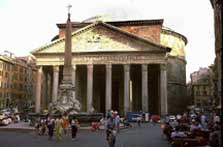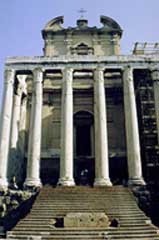

Here are a few select digitally remastered or current photographs of ancient Roman buildings (click on the thumbnails to enlarge picture):

Notice the Corinthian capitals and non-fluted column shafts and dentiles on the Pantheon. The entablature contains a quote, "MAGRIPPA LF COSTERTIVM FECIT".

This building also has Corinthian capitals with fluted column shafts. The drums are beginning to crumble due to age. There are also engaged pilars on both sides of the end of the columns.

This is the famous Pantheon building. Notice the obelisk in the front of the building. The oculus was an architectural design the Romans took from the Egyptians and used for decorative pieces. The Pantheon's columns have Corinthian capitals and non-fluted shafts. There are dentiles along the pediment as well.

This is the Parthenon, an ancient Greek building. This is a view of the side colonnade. The Greeks almost always used Doric capitals because the Romans began using other capitals only after conquering the Greeks. A hint that this is a Greek building is because Greeks built their temples high on hills or mountains and away from any other buildings or structures.

This is a view of the facade of the Parthenon. They had metopes and triglyphs above the Doric capitals, along the entablature and unlike Roman buildings which were built on platforms, Greek buildings had stylobates.

This is the Stola of Attalus, an ancient Greek "shopping mall" and commercial center. These columns are non-fluted and have Ionic capitals. This is a large colonnade and if you notice on the left side in the background, the doorways display a prime example of the post and lintel design.

This is the Temple of Antoninus and Faustina, an ancient Roman temple. It has Corinthian capitals and unique baroque architectural designs (the curves at the top of the building). If you look at the second story which is above the columns you will notice the numerous engaged pilars.
| 







